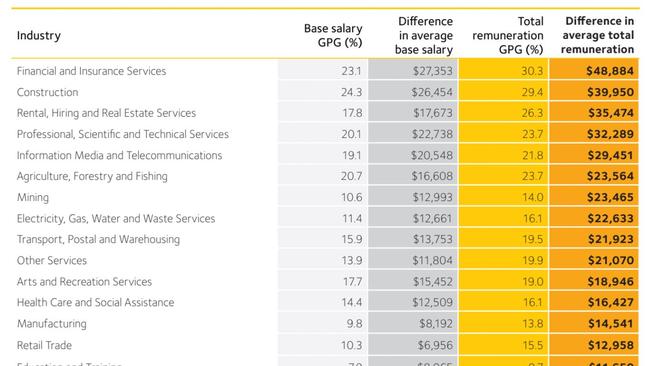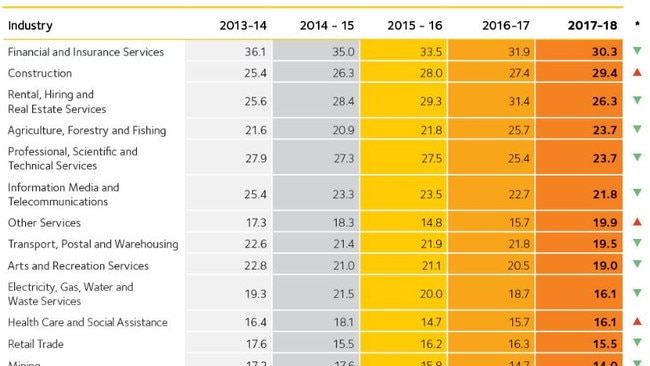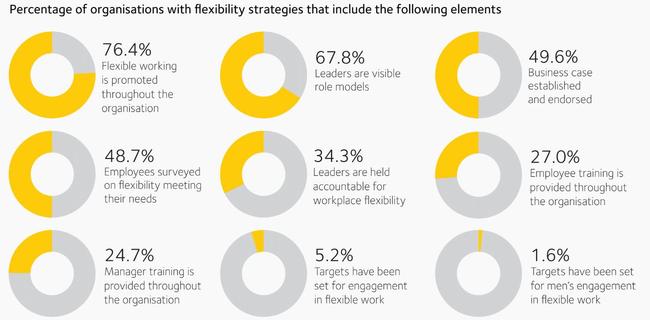Pay gap improving, but remains far worse in certain industries
Some Australians are earning tens of thousands of dollars less than their colleagues. These jobs are the worst offenders.
THE pay gap between men and women is gradually improving — but certain jobs are still far worse than others.
The Workplace Gender Equality Agency (WGEA) has released a new report today detailing Australia’s progress on the pay gap. It contains some positive news.
While men still out-earn women by an average of 21.3 per cent, that number has just recorded its biggest ever drop in a single year since the agency started collecting data.
Five years ago, the gap was 24.7 per cent.
WGEA Director Libby Lyons said the result was cause for cautious but tempered optimism.
“Although the gender pay gap has narrowed every year, progress is too slow,” Ms Lyons said.
“Access to parental leave has not improved, with the provision of paid primary carer’s leave actually going backwards. The glass walls persist in industry segregation, which remains deeply entrenched in Australia. The glass ceiling is still a barrier for women at the CEO and board levels.
“The first five years of data shows where we are seeing positive change and where we need to make more effort. We now need even more employers to take action so that we can accelerate the momentum for gender equality in Australian workplaces.”
The report concludes there is still a gender pay gap in “every industry and occupation”, with no exceptions.
The biggest factors behind that disparity include non-salary benefits such as bonuses, a reliance on awards and collective agreements in some jobs and the concentration of men and women in certain industries.
The pay gap is widest in the financial and insurance services industry, with an average difference of $48,884 between men and women’s total remuneration.
If you’re a woman working in real estate, construction, science, telecommunications or agriculture, chances are you are being severely undervalued as well.
Even some female-dominated industries are not immune. For example, the pay gap in the health care and social assistance sector actually increased over the last year.
“I think part of the issue is that because they think they are a female-dominated industry, they don’t need to do anything, and that is absolutely wrong,” Ms Lyons told Channel 9 this morning.
“They need to recognise they have far too many men in management positions. They also need to recognise they need to get more men in the lower paying caring roles where men can actually have very rewarding and sustainable careers.”


One of the fundamental problems Australian women face is described in the report as an “action gap”.
An increasing number of companies are analysing pay data to identify the disparity among their employees, but over 40 per cent of them are taking no action to actually fix it.
“We are making it a priority in this coming year to contact all of those organisations who have done a pay gap analysis but have taken no action to find out why, to provide them with support and the tools they may need to take action to close that gap,” Ms Lyons told AAP.
She said many companies simply “don’t know where to start”.
“I think HR departments take the initiative to do a pay gap analysis, get the results and are quite shocked by what they’ve seen and fear taking it up the chain to the executives and the board,” Ms Lyons said.
“They then sweep it under the carpet and think it will go away.”
There are some simple first steps companies can take, such as reporting the disparity to executives and reviewing decision-making around remuneration.
It is also important to ensure employees have access to flexible working arrangements.
Three-quarters of businesses do have strategies in place for that, but only a third of them hold their leaders accountable for workplace flexibility, and just 5 per cent have set targets for their employees' engagement in flexible work.
On top of that, more than half of companies provide no access to paid parental leave beyond the government’s scheme — a problem that overwhelmingly affects women.

The gender gap debate is always fiery, and it blew up again this morning as Channel 7’s morning show Sunrise hosted a discussion of the report’s findings.
“I will have a stab in the dark for companies and try to come up with an idea. What about pay up? It is really not that hard,” Cath Webber from Women in Media told the program.
“It’s time for action. Find the money and pay. Let’s go.”
Ms Webber clashed with Smooth FM newsreader Ron Wilson, who said international studies proved the issue wasn’t that simple.
“It seems, they’re saying, that women are actually prepared to work for less. Now that could be the problem,” Mr Wilson said.
“It’s always been lumped on the employers. I think as individual employees, we need to do more to make ourselves more valuable to the employer, male or female.
“We have to look at a balance. It’s no good just saying it’s all about males being paid more, there’s more to it in the workplace than just that fact.”
“That’s blaming women again, Ron,” Ms Webber protested.
“No it’s not blaming women. It’s saying the individual needs to take more responsibility. It’s not just a gender issue,” he said.
Speaking to the media this afternoon, Minister for Women Kelly O’Dwyer said the government wanted “to provide more opportunity for women to participate in the workforce,” emphasising the need for flexible work.
“One of the reasons that there is a gender pay gap is because more women have been taking on caring responsibility for their families, often by choice, but not always,” Ms O’Dwyer said.
Originally published as Pay gap improving, but remains far worse in certain industries

